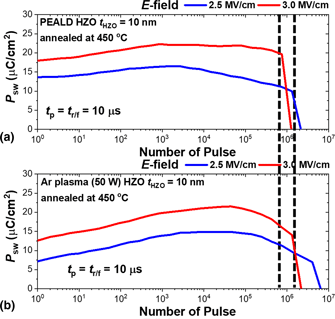Crossref Citations
This article has been cited by the following publications. This list is generated based on data provided by
Crossref.
Zhang, Shujun
Malič, Barbara
Li, Jing-Feng
and
Rödel, Jürgen
2021.
Lead-free ferroelectric materials: Prospective applications.
Journal of Materials Research,
Vol. 36,
Issue. 5,
p.
985.
Hasan, Md Mehedi
Mohit
Islam, Md Mobaidul
Bukke, Ravindra Naik
Tokumitsu, Eisuke
Chu, Hye-Yong
Kim, Sung Chul
and
Jang, Jin
2022.
Improvement of Amorphous InGaZnO Thin-Film Transistor With Ferroelectric ZrOx/HfZrO Gate Insulator by 2 Step Sequential Ar/O2 Treatment.
IEEE Electron Device Letters,
Vol. 43,
Issue. 5,
p.
725.
Kang, Seunghun
Jang, Woo-Sung
Morozovska, Anna N.
Kwon, Owoong
Jin, Yeongrok
Kim, Young-Hoon
Bae, Hagyoul
Wang, Chenxi
Yang, Sang-Hyeok
Belianinov, Alex
Randolph, Steven
Eliseev, Eugene A.
Collins, Liam
Park, Yeehyun
Jo, Sanghyun
Jung, Min-Hyoung
Go, Kyoung-June
Cho, Hae Won
Choi, Si-Young
Jang, Jae Hyuck
Kim, Sunkook
Jeong, Hu Young
Lee, Jaekwang
Ovchinnikova, Olga S.
Heo, Jinseong
Kalinin, Sergei V.
Kim, Young-Min
and
Kim, Yunseok
2022.
Highly enhanced ferroelectricity in HfO
2
-based ferroelectric thin film by light ion bombardment
.
Science,
Vol. 376,
Issue. 6594,
p.
731.
Kim, Jin-Hyun
Onaya, Takashi
Park, Hye Ryeon
Jung, Yong Chan
Le, Dan N.
Lee, Minjong
Hernandez-Arriaga, Heber
Zhang, Yugang
Tsai, Esther H. R.
Nam, Chang-Yong
Nabatame, Toshihide
Kim, Si Joon
and
Kim, Jiyoung
2023.
Toward Low-Thermal-Budget Hafnia-Based Ferroelectrics via Atomic Layer Deposition.
ACS Applied Electronic Materials,
Vol. 5,
Issue. 9,
p.
4726.
Guo, Xiaowei
Wang, Fang
Ma, Zexia
Shan, Xin
Lin, Xin
Ji, Yujing
Zhao, Xuanyu
Feng, Yulin
Han, Yemei
Xie, Yangyang
Song, Zhitang
and
Zhang, Kailiang
2023.
Optimization of Subthreshold Swing and Hysteresis in Hf0.5Zr0.5O2-Based MoS2 Negative Capacitance Field-Effect Transistors by Modulating Capacitance Matching.
ACS Applied Materials & Interfaces,
Vol. 15,
Issue. 26,
p.
31617.
Choi, Yejoo
Shin, Jaemin
Moon, Seungjun
Min, Jinhong
Han, Changwoo
and
Shin, Changhwan
2023.
Experimental study of endurance characteristics of Al-doped HfO2 ferroelectric capacitor.
Nanotechnology,
Vol. 34,
Issue. 18,
p.
185203.
Ahn, Yeonghwan
Jeon, Yerin
Lim, Seokwon
Kim, Jiwoong
Kim, Jisu
Duy, Le Thai
and
Seo, Hyungtak
2023.
Effects of plasma power on ferroelectric properties of HfO2-ZrO2 nanolaminates produced by plasma enhanced atomic layer deposition.
Surfaces and Interfaces,
Vol. 37,
Issue. ,
p.
102669.
Park, Won-Ji
Kim, Ha-Jung
Lee, Joung-Ho
Kim, Jong-Hwan
Uhm, Sae-Hoon
Kim, So-Won
and
Lee, Hee-Chul
2024.
Characterization of HZO Films Fabricated by Co-Plasma Atomic Layer Deposition for Ferroelectric Memory Applications.
Nanomaterials,
Vol. 14,
Issue. 22,
p.
1801.
Di Zhang, Wen
Li, Bing
Wang, Wei Wei
Wang, Xing Ya
Cheng, Yan
and
Jiang, An Quan
2026.
Ultrahigh Dielectric Permittivity of a Micron-Sized Hf0.5Zr0.5O2 Thin-Film Capacitor After Missing of a Mixed Tetragonal Phase.
Nano-Micro Letters,
Vol. 18,
Issue. 1,



